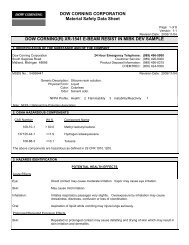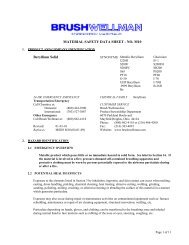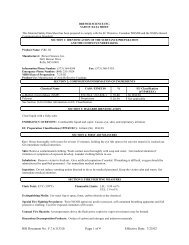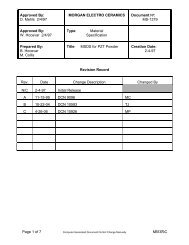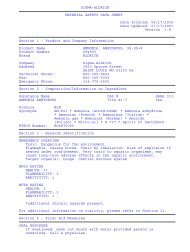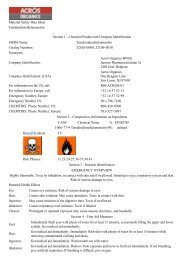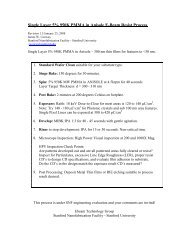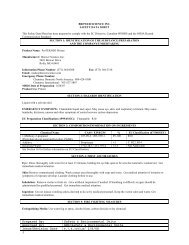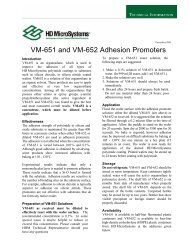EE 410 / Saraswat Handout #3 - Stanford Nanofabrication Facility
EE 410 / Saraswat Handout #3 - Stanford Nanofabrication Facility
EE 410 / Saraswat Handout #3 - Stanford Nanofabrication Facility
Create successful ePaper yourself
Turn your PDF publications into a flip-book with our unique Google optimized e-Paper software.
<strong>EE</strong><strong>410</strong> / <strong>Saraswat</strong> <strong>Handout</strong> <strong>#3</strong><br />
• Rework as necessary.<br />
4J. Week #5: Lab Section<br />
20. Oxide Etch (STEPS 5.200-5.260)<br />
Vernier #51: CONT to ACTIVE (offset: ____ / ____ )<br />
Vernier #53: CONT to POLY (offset: ____ / ____ )<br />
Postbake: 30 min @ 110°C in the oven<br />
Plasma Contact Etch:<br />
For the contacts we do not etch wet. While we would like sloped contact walls for good<br />
aluminum coverage, the contact holes are small and close together, so we need steep sidewalls.<br />
Also, PSG can etch laterally very fast, so we choose a plasma etch.<br />
• Note: Always run the AMT for 10 to 15 min prior to processing any device wafers.<br />
This conditions the chamber and produces a more uniform etch.<br />
• Also, always review the program to be sure the setup has not been changed. Record the<br />
actual readouts on the runsheet (see below).<br />
• Note: This process etches undoped and undensified LTO ~40 nm/min, silicon > 5<br />
nm/min.<br />
• Etch T test wafer first. The Nano-spec reading should be "less than 20 A". Etch the rest of<br />
the wafers for the same time.<br />
• AMT - Oxide etch conditions:<br />
Trans Power: 1100 W (typical) ________(actual)<br />
Rfld Power: 20 W (typical) ________(actual)<br />
Bias: - 535 V ________(actual)<br />
O2 flow: 6 sccm (Gas 1) ________(actual)<br />
CHF3 flow: 86 sccm (Gas 2) ________(actual)<br />
Pressure: 40 mT ________(actual)<br />
Hexode Temp: 22°C ________(actual)<br />
Time: (To be calculated) ________(actual)<br />
• Check etched areas with the Nanospec to insure that etching is complete.<br />
Photoresist Removal and Clean:<br />
The oxide etch hardens the resist so that piranha alone cannot clear the wafers. Therefore the<br />
resist must be ashed.<br />
• Process using Standard Hard Resist Strip.<br />
• Inspect to be sure that the resist has been removed.<br />
Revised Jan. 11, 2008 Page 27/47




